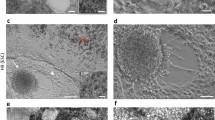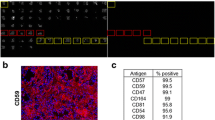Abstract
Inherited visual disorders, major cause of visual impairment, can be subdivided into inherited retinal dystrophies (iRD), due to the progressive loss of photoreceptors and retinal pigment epithelium, or inherited optic neuropathies (iON), due to the loss of retinal ganglion cells whose axons form the optic nerve. IRDs and IONs represent two genetically and clinically heterogeneous groups for which cell replacement is one of the most encouraging therapeutic strategies.
For stem cell-based therapy, using human induced pluripotent stem cells (iPSCs) is crucial to obtain a relatively homogenous cell population to be transplanted. We will present effective strategies based on magnetic-activated cell sorting to select transplantable retinal ganglion cells or photoreceptors by targeting a cell surface antigen specifically expressed in each of the two retinal cell types from human iPSC-derived retinal organoids.
Access this chapter
Tax calculation will be finalised at checkout
Purchases are for personal use only
Similar content being viewed by others
Notes
- 1.
Note that others separators may be more adapted to specific experiments, notably according to the number of organoids and cell number during isolation process
References
Stenkamp DL (2015) Development of the vertebrate eye and retina. In: Teplow DB (ed) Progress in molecular biology and translational science. Elsevier, Amsterdam, pp 397–414
Miesfeld JB, Brown NL (2019) Eye organogenesis: a hierarchical view of ocular development. In: Schatten G (ed) Current topics in developmental biology. Elsevier, Amsterdam, pp 351–393
Casey MA, Lusk S, Kwan KM (2021) Build me up optic cup: intrinsic and extrinsic mechanisms of vertebrate eye morphogenesis. Dev Biol 476:128–136
Boije H, MacDonald RB, Harris WA (2014) Reconciling competence and transcriptional hierarchies with stochasticity in retinal lineages. Curr Opin Neurobiol 27:68–74
Jin K (2017) Transitional progenitors during vertebrate retinogenesis. Mol Neurobiol 54:3565–3576
Lu Y, Shiau F, Yi W et al (2020) Single-cell analysis of human retina identifies evolutionarily conserved and species-specific mechanisms controlling development. Dev Cell 53:473–491.e9
Sridhar A, Hoshino A, Finkbeiner CR et al (2020) Single-cell transcriptomic comparison of human fetal retina, hPSC-derived retinal organoids, and long-term retinal cultures. Cell Rep 30:1644–1659.e4
Mao X, An Q, Xi H et al (2019) Single-cell RNA sequencing of hESC-derived 3D retinal organoids reveals novel genes regulating RPC commitment in early human retinogenesis. Stem Cell Rep 13:747–760
Kruczek K, Swaroop A (2020) Pluripotent stem cell-derived retinal organoids for disease modeling and development of therapies. Stem Cells 38:1206–1215
O’Hara-Wright M, Gonzalez-Cordero A (2020) Retinal organoids: a window into human retinal development. Development 147:dev189746
Llonch S, Carido M, Ader M (2018) Organoid technology for retinal repair. Dev Biol 433:132–143
Lamba DA, Karl MO, Ware CB, Reh TA (2006) Efficient generation of retinal progenitor cells from human embryonic stem cells. Proc Natl Acad Sci 103:12769–12774
Nakano T, Ando S, Takata N et al (2012) Self-formation of optic cups and storable stratified neural retina from human ESCs. Cell Stem Cell 10:771–785
Meyer JS, Howden SE, Wallace KA et al (2011) Optic vesicle-like structures derived from human pluripotent stem cells facilitate a customized approach to retinal disease treatment. Stem Cells 29:1206–1218
Reichman S, Terray A, Slembrouck A et al (2014) From confluent human iPS cells to self-forming neural retina and retinal pigmented epithelium. Proc Natl Acad Sci 111:8518–8523
Zhong X, Gutierrez C, Xue T et al (2014) Generation of three-dimensional retinal tissue with functional photoreceptors from human iPSCs. Nat Commun 5:4047
Reichman S, Slembrouck A, Gagliardi G et al (2017) Generation of storable retinal organoids and retinal pigmented epithelium from adherent human iPS cells in xeno-free and feeder-free conditions. Stem Cells 35:1176–1188
Capowski EE, Samimi K, Mayerl SJ et al (2019) Reproducibility and staging of 3D human retinal organoids across multiple pluripotent stem cell lines. Development 146:dev171686
Wahlin KJ, Maruotti JA, Sripathi SR et al (2017) Photoreceptor outer segment-like structures in long-term 3D retinas from human pluripotent stem cells. Sci Rep 7:766
da Silva S, Cepko CL (2017) Fgf8 expression and degradation of retinoic acid are required for patterning a high-acuity area in the retina. Dev Cell 42:68–81.e6
Stevens CB, Cameron DA, Stenkamp DL (2011) Plasticity of photoreceptor-generating retinal progenitors revealed by prolonged retinoic acid exposure. BMC Dev Biol 11:51
Brooks MJ, Chen HY, Kelley RA et al (2019) Improved retinal organoid differentiation by modulating signaling pathways revealed by comparative transcriptome analyses with development in vivo. Stem Cell Rep 13:891–905
Li L, Zhao H, Xie H et al (2021) Electrophysiological characterization of photoreceptor-like cells in human inducible pluripotent stem cell-derived retinal organoids during in vitro maturation. Stem Cells 39:959–974
Fligor CM, Lavekar SS, Harkin J et al (2021) Extension of retinofugal projections in an assembled model of human pluripotent stem cell-derived organoids. Stem Cell Rep 16:1–14
Gabriel E, Albanna W, Pasquini G et al (2021) Human brain organoids assemble functionally integrated bilateral optic vesicles. Cell Stem Cell 28:1–18
VanderWall KB, Huang KC, Pan Y et al (2020) Retinal ganglion cells with a glaucoma OPTN(E50K) mutation exhibit neurodegenerative phenotypes when derived from three-dimensional retinal organoids. Stem Cell Rep 15:52–66
Lane A, Jovanovic K, Shortall C et al (2020) Modeling and rescue of RP2 retinitis pigmentosa using iPSC-derived retinal organoids. Stem Cell Rep 15:67–79
Deng W-L, Gao M-L, Lei X-L et al (2018) Gene correction reverses ciliopathy and photoreceptor loss in iPSC-derived retinal organoids from retinitis pigmentosa patients. Stem Cell Rep 10:1267–1281
Huang K-C, Wang M-L, Chen S-J et al (2019) Morphological and molecular defects in human three-dimensional retinal organoid model of X-linked juvenile retinoschisis. Stem Cell Rep 13:906–923
Artero Castro A, Rodríguez Jimenez FJ, Jendelova P et al (2019) Deciphering retinal diseases through the generation of three dimensional stem cell-derived organoids: concise review. Stem Cells 37:1496–1504
Parfitt DA, Lane A, Ramsden CM et al (2016) Identification and correction of mechanisms underlying inherited blindness in human iPSC-derived optic cups. Cell Stem Cell 18:769–781
Shirai H, Mandai M, Matsushita K et al (2016) Transplantation of human embryonic stem cell-derived retinal tissue in two primate models of retinal degeneration. Proc Natl Acad Sci U S A 113:E81–E90
Mandai M, Fujii M, Hashiguchi T et al (2017) iPSC-derived retina transplants improve vision in rd1 end-stage retinal-degeneration mice. Stem Cell Rep 8:69–83
Gagliardi G, Ben M’BK, Chaffiol A et al (2018) Characterization and transplantation of CD73-positive photoreceptors isolated from human iPSC-derived retinal organoids. Stem Cell Rep 11:665–680
Rabesandratana O, Chaffiol A, Mialot A et al (2020) Generation of a transplantable population of human iPSC-derived retinal ganglion cells. Front Cell Dev Biol 8:585675
Ribeiro J, Procyk CA, West EL et al (2021) Restoration of visual function in advanced disease after transplantation of purified human pluripotent stem cell-derived cone photoreceptors. Cell Rep 35:109022
Slembrouck-Brec A, Rodrigues A, Rabesandratana O et al (2019) Reprogramming of adult retinal Müller glial cells into human-induced pluripotent stem cells as an efficient source of retinal cells. Stem Cells Int 2019:1–13
Author information
Authors and Affiliations
Corresponding author
Editor information
Editors and Affiliations
Rights and permissions
Copyright information
© 2023 Springer Science+Business Media, LLC, part of Springer Nature
About this protocol
Cite this protocol
Orieux, G., Rabesandratana, O., Gagliardi, G., Goureau, O. (2023). Generation and Isolation of Retinal Ganglion Cells and Photoreceptors from Human iPSC-Derived Retinal Organoids by Magnetic-Activated Cell Sorting. In: Gopalakrishnan, J. (eds) Brain Organoid Research. Neuromethods, vol 189. Humana, New York, NY. https://doi.org/10.1007/978-1-0716-2720-4_4
Download citation
DOI: https://doi.org/10.1007/978-1-0716-2720-4_4
Published:
Publisher Name: Humana, New York, NY
Print ISBN: 978-1-0716-2719-8
Online ISBN: 978-1-0716-2720-4
eBook Packages: Springer Protocols




